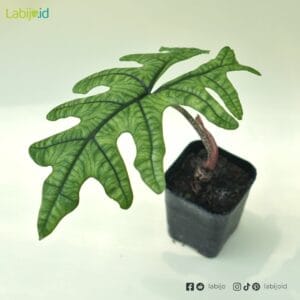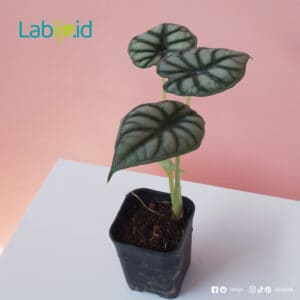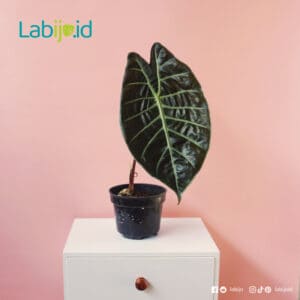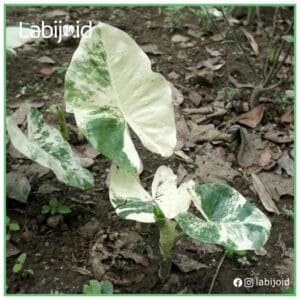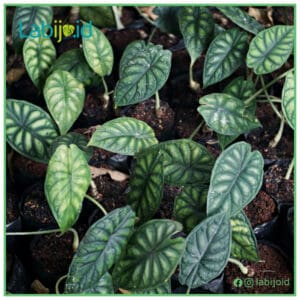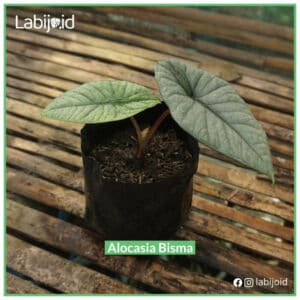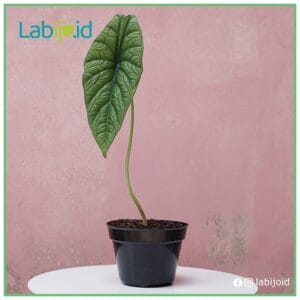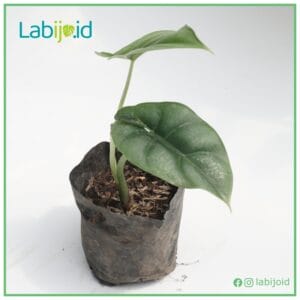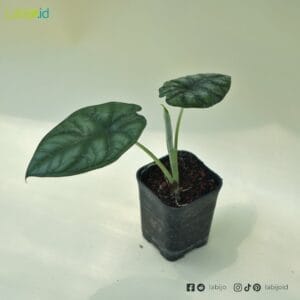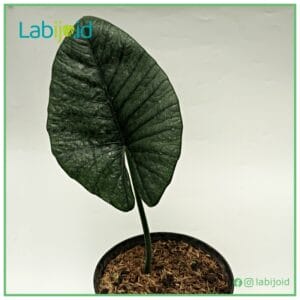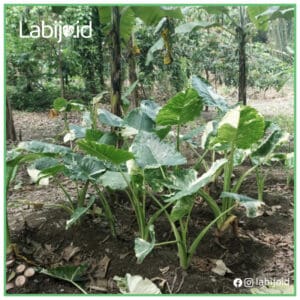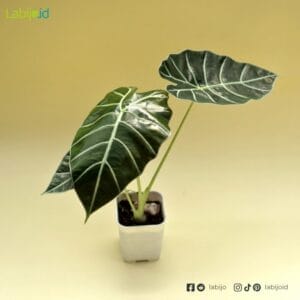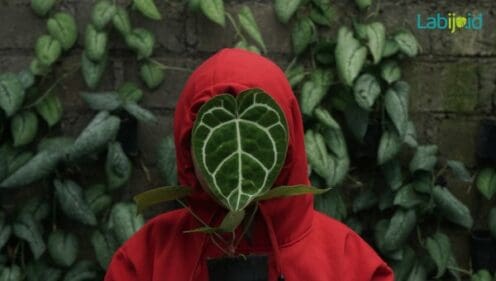If you are looking for decorative plants, Alocasia would be an exciting addition to your collections! But if you are new to taking care of houseplants, and worry that you might not be able to provide a good maintanance for your plants. Here is a short explanation of the characteristic of Alocasia and a few growing guides spesifically for Alocasia that would ease your worries away and
What is Alocasia
Alocasia is a tuberous perennial flowering plant from the Araceae family, and there are over 70 species of Alocasia. Alocasia has wide leaves that look like an elephant ear, that’s why it is often called as “elephant ear” plant. Initially, this plant grows in forests as wild plants. But increasingly becomes popular as tropical houseplants.
How to grow Alocasia
Alocasia dormant in dry season and will be better if it’s kept in a wet and low light place because they are naturaly they live in forest floor and near the river. If you asking how to grow alocasia, you need to make place that imitate as close as possible from their real environment. Even though it’s typically grown as a pot plant for indoor houseplants.
In winter, you need to put alocasia indoor to make it still warm, you also need some water but not too much. Because in winter the water will evaporating so slow. Dry soil in winter is fine. If no leaves during winter is okay, you just need bring the tuber in soil and place it in room temperature to prevent the tuber frozing. The leaves will grow again in spring. We will write another detailed article about how to take care Alocasia during Winter.
Soil
For soil, you can plant them in organic loose soil which contain a good amount of peat moss. Before watering, you can let the top of the soil dry first, and then consider aerating the soil. Alocasia needs a well-drained potting mix, so make sure the soil has a proper drainage to prevent waterlogging. Soggy soil can makes the plant susceptible to many fungal infections
Light
It depends on the variety, some Alocasia may need a full-sunlight, while some others prefer to be kept in shady area. But mostly Alocasia tends to love bright but diffuse light, this will help the plant to produce/grow better leaf with nice color, remember to keep the plant away from direct sunlight that would cause to burn the leaves.
Water
Although Alocasia is water-loving plants, they don’t like overwatering since that makes them sitting in too soggy and wet soil. Wet leaves, stem, and soil often lead to yellowing and crispier leaves and it would invite some serious fungal infections. So try to moist the soil evenly, and allow a few inches from the top a dry-out before watering. Never let them sit in wet, and in order to do that you can use a pot with drainage holes and a tray underneath it. Let it dry for 10 minutes after watering, and dump out the extra water from the tray.
Temperature and Humidity
Alocasia thrives in a humid and moist environment. Which means Alocasia is a type of plant that needs to be placed on a tray filled with pebbles and water in order to increase humidity around the plant. Although we are encouraged to mist the plant, try not to get the leaves and stem too wet. Alocasia prefers warm temperature and it can suffer below 60 degrees Fahrenheit or 15° C. Keep them away from air conditioning.
Fertilizer
You can use frequently feed Alocasia with liquid fertilizer because they can be heavy feeders, especially the large alocasia specimens. You also can using small applications of granule fertilizer.
Potting and Repotting
After getting Alocasia from shipping, don’t forget to re-pot the plant into a larger pot free-draining potting soil. It’s best to separate and re-pot the rhizome to manage the size of the plant and keep increasing your collection. Plant the rhizomes by keeping the top of the rhizomes above the soil line to ensure the plan remains growing. The Alocasia plant prefers a tight fit in its pot, so don’t re-pot too often.
Propagating Alocasia
Plant division is the best way to propagate, in Alocasia case they usually propagate by a rhizome and clump division. You can cut a piece of underground rhizome and plant it separately in a new pot, and then wait as the new growth appears. Propagation is best done in spring.
Varieties of Alocasia Plants
There are over 70 species of Alocasia. Alocasia is primarily hybridized based on their appearances such as size, leaf form, and color. This plant has been extensively hybridized in addition. Most varieties are topical so they need to be in an area with the warm temperature and high humidity, we can’t forget to plant Alocasia in well-drained pots and place them in partial sun or a shaded area but oftentimes they would likely appreciate brighter filtered sunlight. Remember to always cut off the falling leaves to keep the plant healthy. Like all aroids, Alocasias flower with a typical spathe and spadix.
Common Pests and Diseases
There are quite a few of diseases that commonly infect Alocasia plants such as crown, stem, and root rot, leaf spot, and Xanthamonas. These diseases are mostly caused by over-watering the plant, and wet leaves. You can see the signs which usually appear as dark brown or black spots on the leaves, surrounded by a yellowish rim.
The disease can be prevented by avoiding over-watering, and not letting the leaves wet and leave them dry, also providing good air circulation around the plant. Once you see it infected, you can quickly trim away the damaged leaves and throw away the dropping ones. This way helps the plant to stay healthy.
Common pests of Alocasia plants are mealy bugs, scale, aphids, and spider mites. You can prevent them by spraying soapy water to the leaves to make the leaves dust-free and healthy.
Toxicity of Alocasia Plants
Alocasia is a very poisonous plant with insoluble oxalate crystals on the leaves. Usually when the pet chews or bites the leaves, they will immediately release the crystal. With that being said, if it makes any contact with mouth, it will cause swelling and irritation that can make it hard to breathe but this case is very rare to happen. With that reason, this plant should be kept out of the reach of small children and pets.
See? There isn’t much to do when it comes to taking care of your houseplants. You just need to be aware of your plant’s preference and need, and you will no longer worry about having them around in your house. Happy plants!
Alocasia For Sale
We have many rare alocasia for sale that can ship worldwide. Door to door shipping using DHL. Its about a week. Only USD 30 for shipping arround US and Asia. If you in European you need to pay USD 10 more for shipping. So its about USD 40. Up to 10 plants in medium size. So if you want to get cheap shipping cost, you need to order more. We will give you discount if you order more than 10 plants.
-
 Alocasia JacklynOriginal price was: $69.$39Current price is: $39.
Alocasia JacklynOriginal price was: $69.$39Current price is: $39. -
 Alocasia Baginda Grey Dragon$69
Alocasia Baginda Grey Dragon$69 -
 Alocasia SuhirmanianaOriginal price was: $49.$39Current price is: $39.
Alocasia SuhirmanianaOriginal price was: $49.$39Current price is: $39. -
 Wholesale 10 Alocasia Macrorrhiza Smaller Size$269
Wholesale 10 Alocasia Macrorrhiza Smaller Size$269 -
 Wholesale 10 Alocasia Dragon Scale$129
Wholesale 10 Alocasia Dragon Scale$129 -
 Wholesale 10 Alocasia Bisma$129
Wholesale 10 Alocasia Bisma$129 -
 Alocasia PuncakborneensisOriginal price was: $49.$29Current price is: $29.
Alocasia PuncakborneensisOriginal price was: $49.$29Current price is: $29. -
 Alocasia ReversaOriginal price was: $80.$59Current price is: $59.
Alocasia ReversaOriginal price was: $80.$59Current price is: $59. -
 Alocasia Dragon ScaleOriginal price was: $49.$29Current price is: $29.
Alocasia Dragon ScaleOriginal price was: $49.$29Current price is: $29. -
 Alocasia Reginae$29
Alocasia Reginae$29 -
 Alocasia Gageana Macrorrhiza Variegated$29 – $199
Alocasia Gageana Macrorrhiza Variegated$29 – $199 -
 Alocasia WatsonianaOriginal price was: $49.$29Current price is: $29.
Alocasia WatsonianaOriginal price was: $49.$29Current price is: $29.
